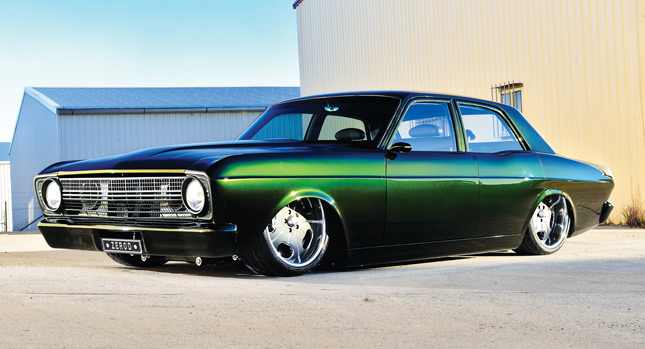Joining the local introductions and even some world premieres like the Lexus LF-LC II at the 2012 Australian International Motor Show in Sydney this October will be a unique muscle car build from the Land Down Under.
Australia is known for its love of muscle cars and has a long tradition in the category with vehicles such as the classic 1970s Ford Falcon GTHO Phase III, Holden Monaro and Torana V8s, and Valliant Charger R/Ts (Chrysler Group), as well as the contemporary offerings from Holden’s HSV and Ford’s FPV performance divisions.
Now, an Australian has come up with a green muscle car build – and we’re not referring to its beautiful, rich exterior shade.
Named the ZERO’D and billed as the “world’s first elite eco-friendly custom-built muscle car”, the four-door saloon is based on a 1967 Ford XR Falcon. It’s the brainchild of Mick Fabar, owner of Green Homes Australia, who wanted to create a muscle car with a green footprint – not only when it came to power, but it’s construction as well.
“I wanted to create a street machine that had ideally a zero effect on the environment in its design, construction and when being driven,” said Mick Fabar.
“I’d been looking into the future and trying to figure out what kind of car my son would be building when he was 16 … The challenge sort of evolved from there. I did some research into biodiesel fuels and figured we should put that into a car and see what horsepower we could get. It really didn’t cost anymore to build this car; it just required applying some basic principles.”
The ZERO’D was fitted with a 7.3-liter Ford Powerstroke turbocharged V8 diesel capable of delivering 600-ponies to the rear wheels through an Allison four-speed automatic transmission.
The V8 was modified to run on commercially available B20 biofuel (20% bio, 80% diesel fuel), in which case, exhaust emission are reduced up to 70 per cent, “whilst still delivering impressive horsepower and torque”, according to Fabar.
What’s even more impressively green about the ZERO’D is that it was built using primarily recycled materials. All exterior body panels of the Falcon are second-hand and its hand-stitched black leather interior trim is made entirely from hide off-cuts and ‘seconds’ that would normally be discarded, while the nuts and bolts are also recycled.
Fabar says that only a handful of new components were used, including rubbers and glass since replacements were not available in good condition, plus the radiator and intercooler which had to be specially made to suit the car’s custom front end.
Other new parts are said to have been sourced from eco-friendly developments, including the tires from Distillate Aromatic Extract oils (DAE) and a low emission base paint.
The owner says it took 11 months to plan and seven months to build the car, with Queensland’s Bond University documenting every step of the build to ensure the production team maintained its carbon footprint of zero.
PHOTO GALLERY









